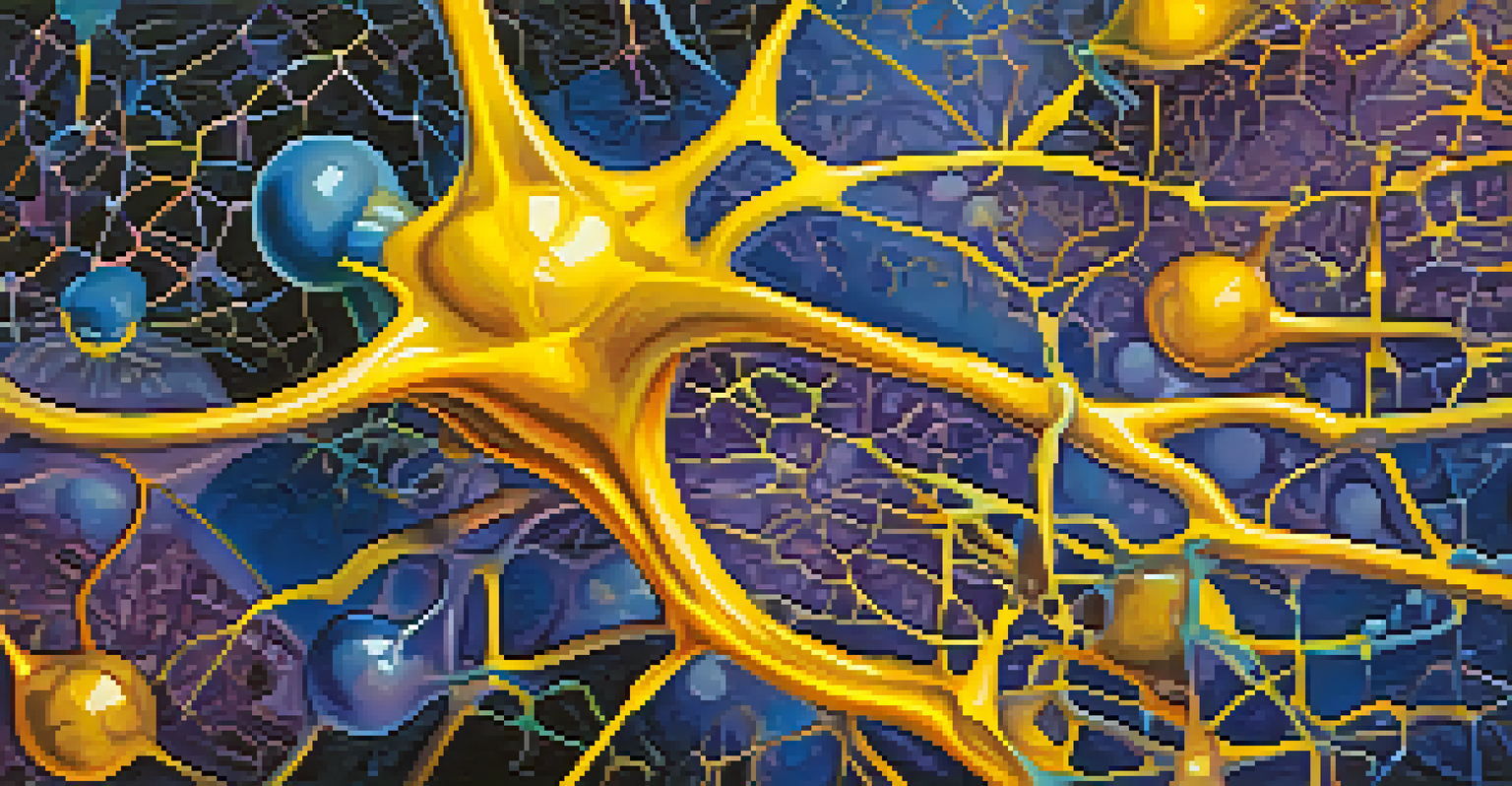Understanding the Pharmacology of Hallucinogens: An Overview

What Are Hallucinogens and Their Types?
Hallucinogens are substances that alter perception, mood, and cognitive processes. These drugs can induce vivid visual and auditory hallucinations, leading users to experience reality in a profoundly different way. Common types include classic hallucinogens like LSD and psilocybin, as well as dissociative drugs such as PCP and ketamine.
The mind is everything. What you think, you become.
Each category has its own unique effects and mechanisms of action, which can vary significantly from one substance to another. For instance, LSD primarily affects serotonin receptors, while ketamine acts on NMDA receptors, leading to its dissociative effects. Understanding these differences is crucial for both researchers and users alike.
As research into these substances expands, so does our understanding of their potential therapeutic benefits and risks. This overview sets the stage for a deeper exploration of their pharmacological intricacies.
The Brain's Chemistry: How Hallucinogens Work
Hallucinogens primarily exert their effects by interacting with neurotransmitter systems in the brain, particularly serotonin. When these substances bind to serotonin receptors, they can significantly alter mood, perception, and cognition. This interaction is what leads to the intense experiences associated with hallucinogen use.

For example, when someone consumes LSD, the drug can enhance sensory perceptions and distort reality. Users might experience colors as more vibrant or sounds as more profound, showcasing the drug's ability to enhance sensory input. These experiences highlight the complex relationship between neurotransmitters and our perception of reality.
Understanding Hallucinogens
Hallucinogens alter perception and mood, with various types like LSD and psilocybin having unique effects on the brain.
Moreover, the effects of hallucinogens can vary greatly depending on the dose, the individual's mental state, and the environment in which the drug is taken. This variability underscores the importance of understanding how these substances interact with the brain's chemistry.
The Role of Set and Setting in Hallucinogen Effects
The concepts of 'set' and 'setting' are crucial when discussing hallucinogen experiences. 'Set' refers to the individual’s mindset—how they feel, think, and anticipate the experience. Conversely, 'setting' pertains to the physical and social environment in which the drug is consumed.
The greatest discovery of my generation is that a human being can alter his life by altering his attitude.
Research shows that a positive mindset and a safe, comfortable environment can lead to more enriching experiences. For instance, someone taking psilocybin in a serene forest might have a more profound and positive experience than someone using it in a chaotic party setting. This highlights the importance of context in determining the outcome of hallucinogen use.
Understanding these factors can help mitigate risks and enhance the potential therapeutic benefits of hallucinogens, especially in clinical settings where these substances are being studied for mental health treatments.
Therapeutic Uses of Hallucinogens: A Growing Field
In recent years, there has been a resurgence of interest in the therapeutic potential of hallucinogens. Studies suggest that substances like psilocybin and MDMA may be effective in treating conditions such as PTSD, depression, and anxiety. This has led to a reevaluation of their role in mental health treatment.
For instance, clinical trials have shown that psilocybin therapy can significantly reduce symptoms of depression in patients who have not responded to traditional treatments. Similarly, MDMA-assisted therapy has shown promise in helping individuals process traumatic experiences. These findings are paving the way for a new era in mental health care.
Therapeutic Potential of Hallucinogens
Recent studies suggest hallucinogens like psilocybin and MDMA may effectively treat mental health conditions such as PTSD and depression.
However, while the therapeutic potential is exciting, it’s essential to approach this field with caution and thorough research. Continued studies will help establish best practices and ensure safety as these substances are integrated into therapeutic contexts.
Potential Risks and Side Effects of Hallucinogen Use
While hallucinogens can offer profound experiences, they are not without risks. Side effects can range from mild to severe, including anxiety, paranoia, and in some cases, persistent changes in perception known as Hallucinogen Persisting Perception Disorder (HPPD). Understanding these potential side effects is crucial for anyone considering their use.
Moreover, individuals with a personal or family history of mental health disorders may be at higher risk for adverse effects. For example, someone predisposed to schizophrenia may experience exacerbated symptoms when using hallucinogens. This highlights the importance of screening and caution when using these substances.
Ultimately, responsible use and a thorough understanding of the risks involved are key to minimizing negative outcomes. As research continues, public awareness and education about these risks will be vital in promoting safe practices.
The Legal Landscape of Hallucinogens
The legal status of hallucinogens varies widely across the globe and even within individual countries. In many places, substances like LSD and psilocybin remain classified as illegal, while others have begun to decriminalize or legalize them for therapeutic use. This shifting landscape reflects changing societal attitudes and growing scientific support for their benefits.
For instance, cities like Denver and Oregon have made headlines for decriminalizing psilocybin, allowing for controlled research and therapeutic applications. This movement is often fueled by a desire to explore alternative treatments for mental health issues in a more open-minded legal framework.
Risks and Legal Status
While hallucinogens offer potential benefits, they also carry risks, and their legal status varies widely, influencing accessibility.
However, navigating the legalities can be complex, and individuals must stay informed about their local laws. Understanding the legal landscape is essential for anyone interested in exploring hallucinogens, whether for personal use or in a therapeutic context.
Future Directions in Hallucinogen Research
As research into hallucinogens continues to grow, exciting opportunities and questions arise. Scientists are exploring not only the therapeutic potential of these substances but also their mechanisms of action and long-term effects on the brain. This research could lead to groundbreaking treatments for various mental health conditions.
Additionally, studies are expanding to include diverse populations and a broader range of substances. For example, researchers are beginning to examine the effects of lesser-known hallucinogens, like mescaline and ayahuasca, to understand their potential benefits and risks.

Looking ahead, the future of hallucinogen research holds the promise of new insights into human consciousness, healing, and the complexities of the mind. As we continue to peel back the layers of these substances, we may unlock new pathways for understanding ourselves and treating mental health disorders.